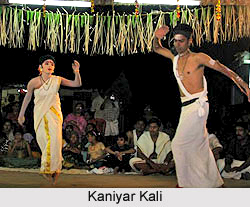 Kanniyar Kali is also known as Desathukali. It is a folk play that has both, dance and theatre elements. Popular in the villages of Palaghat it used to be performed by the Nair community. However one of the main themes dealt with in the Kanniyar porattu is the criticism of the caste differences in society towards communities like Malayan, Kuravan etc who were one-time slaves and dependents of the feudal chieftains of the Malabar area in Kerala. The dance is fast moving and militant performed in the honour of the deity Bhagavathi.
Kanniyar Kali is also known as Desathukali. It is a folk play that has both, dance and theatre elements. Popular in the villages of Palaghat it used to be performed by the Nair community. However one of the main themes dealt with in the Kanniyar porattu is the criticism of the caste differences in society towards communities like Malayan, Kuravan etc who were one-time slaves and dependents of the feudal chieftains of the Malabar area in Kerala. The dance is fast moving and militant performed in the honour of the deity Bhagavathi.
Kaniyar Kali is another variety of interesting performance current in the northern parts of Cochin, conducted in Bhagavati shrines. When the performance come on, there is erected a decorated pandal in the temple adorned with flags and festoons. In the centre a big lighted lamp is placed round which the players dance to set music, both instrumental and vocal, the dance being supposed to be an imitation of the dance of Mahakali and Mahakala. The performance generally continues for three days, the portion for each day being fixed with reference to the music.
On the first day the Andikuttu is held; on the second day comes Valluvon Pattu and on the third, the Malama Pattu. Andikuttu means acting in praise of Andavar, i.e., Subramanya, the issue of Lord Shiva. Valluvon Pattu is in praise of Valluvon who is held to have been a saint and philosopher, and Malama Pattu, was so called, because probably a mountain song was sung. All these songs are highly devotional in sentiment, though here and there may be found references to social incidents. The main performance is done in the temporary hall and each day has its fixed songs. After the songs and dances are over, some farcical element is introduced is represented and ridiculed for their various vices. This portion of the representation is called by the name of Porattu, and its main theme is humour and social satire, each player appearing in costume suitable to the character. On the final day after the songs are over, all the players together, worship the Goddess enshrined in the temple and makes their exit. This is again a queer kind of performance in which music, vocal and instrumental, and dancing and acting play an equally important part: but as in the varieties considered, here also the main and central point of interest is the Bhagavati, enshrined in the temple. Naturally therefore this also deals with the glorification of the Bhagavati mela cult. This is, however, like the Pana, a group or communal celebration, where all males, children and adults, can take part, and is celebrated both as a votive offering and as a temple function




